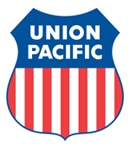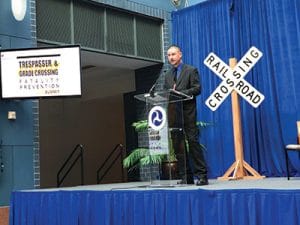Illinois commuter carrier Metra, in conjunction with Operation Lifesaver, has embarked on a series of educational safety blitzes to raise awareness of the importance of safe behavior around its trains and tracks.
The carrier reported in a March 26 news release that the state of Illinois ranked second in the nation in rail fatalities at highway-rail crossings and fifth in the nation in trespassing fatalities. Last year, 47 people were killed and 51 more were injured in Illinois in incidents at grade crossings or along railroad rights-of-way.
Fourteen of the state’s fatalities involved Metra trains, with six occurring at rail crossings. The fatality statistics do not include deaths ruled as suicides or suspected suicides, the carrier said.
“These safety blitzes allow us to reach our customers directly to ensure that they understand the need to stay vigilant about safety around the railroad,” Metra CEO/Executive Director Jim Derwinski said.
The blitzes began in mid-February, and a complete schedule is available here.
The carrier said that its Police Department will also conduct additional enforcement blitzes throughout the region’s six counties and 242 Metra stations. During the enforcement blitzes, citations and warnings will be issued to pedestrians and drivers who ignore gates and warning devices.
Metra also is considering a draft policy that would evaluate station use and is seeking public input, the suburban Daily Herald newspaper reported.
The plan is open for public comment until April 15 and seeks to measure the use and sustainability of the transit system’s stations in relation to ridership.
Most stations labeled as “unsustainable” with less than 10 percent median ridership are on Metra’s Electric Line, but others include Rosemont and Schiller Park on the North Central Service, Mannheim on the Milwaukee District West, and Kedzie on the Union Pacific West, the Daily Herald reports.
The carrier will use the information to make potential changes to improve ridership in the underused stations or in the worst cases make decisions to close stations and create new access points to the system.
More information on the station evaluation policy can be found at this link.
Tag: grade crossing accidents
Your browser does not support the video tag.
Tom Cahill, local chairperson of LCA-049 (CSXT – B&O) and vice president of SMART Transportation Division Local 631 (Brunswick, Md.), was among the presenters at the first Trespasser and Grade Crossing Fatality Prevention Summit hosted by the Federal Railroad Administration in late October.
Cahill, a TD member since January 1997, started working on the railroad out of high school and described to the audience his experience during grade crossing collisions and trespasser incidents.
“None of the job interviews or job descriptions in the transportation sector ever covered what we’re talking about today,” Cahill said. “Nobody talked about the first time that you hit a car at a grade crossing or strike a trespasser that’s on the tracks.”
Those incidents, Cahill said, always have dual victims — the person or people who were struck and the train’s operating crew.
“I’ve been pretty lucky – some people have a trespasser injury or fatality every year,” Cahill said.
Factors such as the location of the operator’s route and the time of day play roles in the frequency of trespasser and grade crossing incidents, but the biggest factor is a distracted public, Cahill said.
The usage of personal electronics has decreased situational awareness of trains by pedestrians to “dangerous levels,” he said. If a pedestrian is on or near tracks and distracted, the risk of an accident increases, especially if they’re wearing headphones or earbuds or looking at their smartphone.
“You’d be surprised by the number of incidents where a survivor would say they never saw or heard the approaching train,” Cahill said.
Trauma for crew
Cahill described to attendees two typical types of incidents that train crews experience – a person is struck and killed instantly or a person or people are struck and then are in need of immediate medical attention.
“In either case, after the train stops, it’s the conductor who is required to walk back to the carnage and do what he can to assist the injured and separate the train to open the road crossing for emergency responders’ vehicles,” he said.
It’s a 50-50 proposition whether the responders arrive on the side where the victim is, if they don’t, then treatment could end up being delayed and a life could be lost.
Separating a train to accommodate the emergency vehicles is always a two-person operation, Cahill said, because handbrakes must be applied to multiple cars by the conductor while the engineer remains in the cab to move the locomotive forward to make room for emergency vehicles.
Cahill made special mention that any reduction of a train’s crew to fewer than two people would likely reduce the survival rate of victims of trespasser-grade crossing incidents.
It also falls to the conductor, who usually sees the incident, to give first aid and to direct first responders.
After the incident, Cahill said, the engineer often will second guess whether the brakes were applied in a timely manner and whether the whistle was sounded in time or for a long enough period. While critical incident programs are offered by carriers to give people time off to recover and get counseling, the post-traumatic stress is difficult to overcome.
“It’s not always that easy,” Cahill said. “We take this home to our wives, to our mothers, to our children. Sometimes it’s hard for them to understand why we can’t just shake it off.”
He told the audience that he’s seen situations where over-the-road workers have been traumatized to the point where they will change to yard service to avoid going out on the road.
Cahill said that there tends to be an uptick of incidences in the fall and the holiday seasons.
The days getting shorter reduces visibility, depression may be setting in with some people with the approach of the holidays and winter.
“The suicides are the absolute worst for us because it’s generally not someone who sprints out at the last second and decides to take their life that way,” Cahill said.
He said often the person is already on the track, perhaps around a bend, awaiting the train.
“I’ve heard it too many times where the last thing the train crew sees or remembers is that person either looking up as the train approaches them or looking back as the train overtakes them,” Cahill said. “It’s very difficult for the train crew. There’s little you can do in those situations.
“It can take up to a mile for us to stop, and even if it doesn’t take that long, the damage is done as soon as we strike the person. It’s traumatic.
“We get back up and we go on and we continue out there. We just hope that we never have another one.”
What can be done?
Cahill presented a list of solutions endorsed by SMART TD to reduce the number of grade crossing and trespasser fatalities.
“We’re front line on this issue. SMART Transportation Division is committed to working with all the stakeholders to reduce crossing and trespassing fatalities,” Cahill said. “We want to be a part of identifying these areas and making sure that we’re doing everything we can to address and fix these incidents one by one to make things safer for the public and the train crews.”
Among them:
- More supplemental safety measures such as four quadrant gates that close the entire crossing so cars cannot bypass the gates, even in poorly constructed intersections.
- Use more channelization devices, such as concrete medians, to keep vehicles from crossing over to drive around gates.
Install stationary horns at crossings that are pointed at motorists, an option that is louder and more focused in getting a driver’s attention. - Grade separations so that roads and tracks do not intersect are the best way to prevent crossing accidents, Cahill said. “It’s a money issue, but there’s nothing better than putting the motoring public above or below the railroad tracks,” he said.
- Install more fencing, especially around rail yards and stations.
- Permanently close as many grade crossings as possible.
The major factor is increasing public awareness, Cahill said. All grade crossing and trespasser fatalities are preventable, but he said that often the last thing that people are thinking about when they approach a railroad track is that there is a 20,000-ton freight train bearing down on them.
“It is critically important to educate the public on their obligations and how to stay safe when they’re around train tracks, rail yards and other places where they may be tempted to trespass on the railroad,” he said.

Click here to read more from Union Pacific.

Feinberg
The following is a written statement by FRA Acting Administrator Sarah Feinberg.
Can one of the nation’s newest, fastest-moving industries help to solve one of transportation’s oldest problems? At the Federal Railroad Administration (FRA), we think the answer is yes. That is why we are proud to announce that Google has agreed to partner with us to make rail crossings safer for drivers and their passengers.
Google has agreed to integrate FRA’s GIS data, which pinpoints the location of the nation’s approximately 250,000 public and private railroad crossings, into its mapping services. Adding railroad crossing data to smartphone mapping applications just makes sense – it means supplying drivers and passengers with additional cues that they are approaching a crossing.
For drivers and passengers who are driving an unfamiliar route, traveling at night, or who lose situational awareness at any given moment, receiving an additional alert about an upcoming crossing could save lives. We know that more and more drivers today use map applications on smartphones to guide them to their destinations. While mobile device maps and applications are trusted sources for directions and guidance, many of them do not notify drivers when they are approaching a rail crossing, or do not identify the rail crossing at all. When drivers are alerted or reminded that there is a rail crossing ahead, they may be more likely to remain alert, use greater caution, and obey the signal crossings.
From the very beginning of his tenure, Secretary Foxx has pushed all of us to do more to integrate technology to raise the bar on safety across all modes of transportation. This partnership, which will allow us to do just that, is an important development. Secretary Foxx and I are incredibly grateful that Google has quickly agreed to work with us, and we are hopeful that other tech companies that develop map applications will join us too.
Last year, approximately 270 people died in highway-rail collisions that were largely preventable. This is the first time this decade in which that number has actually increased from the previous year. We can—and should—do everything possible to end vehicular-train incidents at rail crossings. With Google and other tech companies’ help, I’m confident that we can achieve this goal even faster.
Not long after I arrived at FRA, I promised a fresh look at how to prevent grade crossing accidents. The key so far has been in our partnerships – with local police, to increase enforcement actions; with Operation Lifesaver[external link], to help educate people about the risks; and now, with Google, to help with driver awareness through smarter engineering.
At FRA, we’ll continue to build more of these dynamic partnerships – because we must do everything we can to reduce grade crossing accidents that far too often have tragic consequences.
